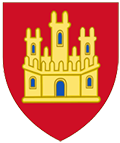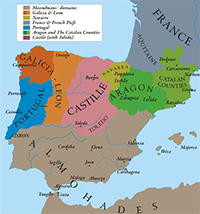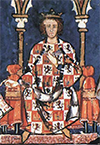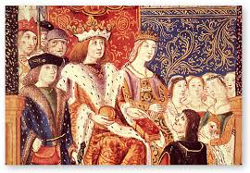Spain's Kingdom of Castile
Castile was a land of independent leaders, the most well-known of which was Count Rodrigo, until the 10th Century, when Fernan Gonzalez took control of all of it at named it Castile. The first King of Castile was Ferdinand I, who took the title in 1035 after his father, Navarre's King Sancho the Great, died. By that time, Sancho had control of Aragon as well, and his son Ramiro I took over that territory. Navarre he left to his son Garcia III. 
Two years later, Ferdinand took control of León. He then ruled for nearly 30 years. At his death, he directed his son Sancho II to rule Castile and his son Alfonso VI to rule León. The latter took over Castile after the suspicious death of his brother. One of Castile's most famous knights—and one of Spain's overall most famous heroes—was El Cid, who led the way to the Christian capture of the important city of Valencia in 1094. His real name was Rodrigo Díaz de Vivar, but he is far more well-known by the name that the Moors gave him, El Cid. He established Valencia as an independent city and kept it that way for nearly a decade. After his death, in 1099, his wife, Jimena Díaz, ruled the city. A Moor army retook the city in 1102. One interloper of sorts was the Navarre king Alfonso the Battler. On his way to extending Navarre's boundaries to their greatest extent, he served also as King of Aragon and King of Castile, the latter by virtue of his marriage to Urraca, then the queen regnant. Alfonso's 25-year reign over Castile ended with his death, in 1134. 
The division precedent was again in effect at Alfonso VII's death, in 1157: Sancho III took Castile and Ferdinand II took León. That Sancho died soon into his reign, and Alfonso VIII claimed the throne. After losing a battle to the Almohads at Alarcos in 1195, Alfonso VIII banded together with Peter II of Aragon and Sancho VII of Navarre and turned back the tide, defeating Almohad forces at the Battle of Las Navas de Tolosa in 1212. In 1230, the León leader, Alfonso XI, died. The King of Castile at that time was Alfonso's son, Ferdinand III; that ruler assumed control of Castile as well. No longer would the two lands be divided. 
Alfonso X, known as the Wise (right), took the Castilian throne in 1252. A proponent of increasing knowledge, he surrounded himself with scholars at court. He directed the creation of a pair of codes of laws, in 1254. These were the Especulo, for the royal court, and the Fuero Real, for municipal law. A revision of the royal court laws became the Siete Partidas. Alfonso X was still on the throne in 1275, when his oldest son, Fernando de la Cerda, died in battle. The king's next oldest son, Sancho, was the heir apparent, but certain nobles preferred Fernando's son, the king's grandson, Alfonso. The conflict progressed, becoming a civil war that ended in 1284 with the victory of the king's son, who became Sancho IV. He fought off another Muslim invasion, then left the crown to Ferdinand IV. Alfonso was still around and made trouble for Ferdinand IV but gave up his quest for the kingship for good in 1304. Ferdinand IV reigned on for another eight years; succeeding him was Alfonso XI, in 1312. That king won an important victory over a Muslim force that combined the efforts of Granada and Morocco. Alfonso's triumph, at Salado River in 1340, prevented future Moroccan invasions. French intervention in such disputes came in the 14th Century. A French force led by Bertrand du Guesclin helped Henry of Trastamara oust his half-brother, King Peter the Cruel, in 1366. Peter was back the following year, taking back the throne helped by an army headed by Edward, Prince of Wales. After the English army left, Henry and the French struck again, killing Peter in 1369. Henry II ruled for a decade, giving way in death to his son John I, who defended his realm against an invasion by England's John of Gaunt, who was the son-in-law of Peter the Cruel by virtue of his 1372 marriage to Peter's daughter Constance. John of Gaunt pursued the crown of Castile for more than two decades, ending his quest finally when Constance died, in 1394. He had led a major invasion in the 1380s and had agreed to end the fighting with a treaty that saw his daughter Catherine married to Henry, the son of King John I. Henry III, who became king at age 12, took the fight to Morocco, scoring a significant triumph there. He also took control of the Canary Islands. He died after 16 years on the throne, and his son, John II, succeeded him. During that king's reign, in 1418, sailors discover the island of Madeira, which be a stepping-stone for many later expeditions to North America. 
Henry IV in 1462 took Gibraltar. He and his son had been again confronting rebellious nobles. Henry named his sister Isabella heir to the throne. In 1469, she married Ferdinand, whose father was King John II of Aragon. Henry's death, in 1474, brought Isabella to the throne. Ferdinand succeeded his father as king in 1479, and the result was the personal and political union of Aragon and Castile.
|
|
Social Studies for Kids
copyright 2002–2025
David White




